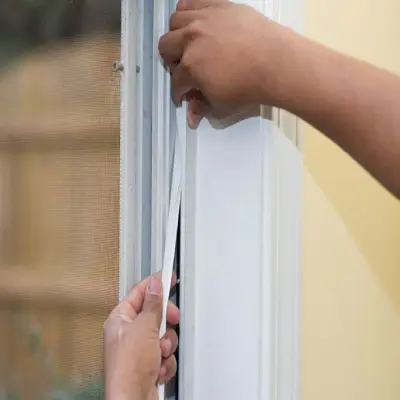Tips on How You Can Stop Drafts
There are a lot of ways that you can fix leaky windows. Some examples:
- Use sealant foam around the edges
- Apply window insulation film
- Use snakes to manually stop air
- Hang heavy drapes around the windows
We recommend that you contact our professionals to see where we can keep your home air-tight and prepared for the winter. We are fully insured, highly qualified, and all of our workmanship is guaranteed.
All Mr. Handyman franchises are locally owned and operated and may offer fewer or more services than those listed here. To learn more about the weatherproofing window services offered in your area, contact your local Mr. Handyman for details or a customized on-site assessment.
Window Weatherproofing FAQs
Mr. Handyman has been helping homeowners repair, maintain, and enhance their spaces for over 25 years! We are the one-stop solution for everything on your to-do list. This includes answering your questions about home repairs, maintenance, and improvements. Here are answers to some of your most frequently asked questions about weatherproofing window services.
What is the best way to weatherproof your windows?
Weatherproofing your windows is a straightforward way to keep your home cozy, energy-efficient, and protected from the elements. Start by sealing any cracks or gaps around the window frames with a high-quality caulk, like silicone, which can flex with temperature changes and last through the seasons, preventing drafts and keeping the air you pay to heat or cool from escaping. If your windows are older, consider adding weatherstripping around the sashes. This simple fix creates a tighter seal when the window is closed, blocking out cold air in the winter and heat in the summer.
Additionally, check for any signs of rot on the windowsills. If you find a damaged or rotten windowsill, it's essential to replace it promptly to prevent further moisture damage and keep your home weatherproof.
What can I put on my windows to keep the cold out?
Weatherproofing windows can be easy–try using window insulation film, a clear plastic sheet that you can shrink into place with a hairdryer. It creates an extra layer between your home and the chilly air outside without blocking your view. For a quick fix, draft stoppers or removable thermal curtains can work wonders, adding an insulating barrier that traps warmth inside.
Another popular choice is applying weatherstripping around the edges of your windows to create a snug seal that keeps drafts from sneaking in. Combine that with a good set of caulk to seal any cracks, and your windows will be ready to handle whatever winter throws your way.
What is the best weather stripping for windows?
When it comes to window weatherproofing, the best weather stripping really depends on your window type and how much sealing power you need. For double-hung or sliding windows, adhesive-backed foam tape is a popular and affordable choice. It’s easy to install, provides a good seal, and works well for smaller gaps. If you need something more durable, a V-strip (also called tension seal) is a flexible plastic or metal strip that presses against the window to block drafts—perfect for creating a long-lasting seal on moving parts.
How do I weatherstrip a window?
To weatherproof windows, clean the window frame thoroughly—dirt and dust can prevent the weatherstripping from sticking properly. Once the surface is clean and dry, measure the areas where the window meets the frame to determine how much weatherstripping you’ll need.
Next, choose the right type of material for your window. An adhesive-backed foam tape is a great option for smaller gaps, while V-strip or silicone weatherstripping works well for sealing around moving parts. Cut the weatherstripping to size, then carefully press it into place along the window’s edges. Once it’s applied, test your window to make sure it still opens and closes smoothly.
How do I seal a window from the outside?
Begin weatherproofing by inspecting the edges of the window frame for gaps or cracks. These are the spots where air, water, or even pests can sneak in. Clean the area thoroughly to remove any dirt, old caulk, or peeling paint, as a clean surface helps the sealant stick better.
Once the frame is prepped, apply a high-quality exterior caulk—silicone or polyurethane-based sealants work best for withstanding the elements. Use a caulk gun to carefully fill in the gaps, running a smooth bead along the seams between the window frame and the siding. For larger openings, consider using expanding foam for extra insulation before sealing with caulk.
 Click to call
Click to call


 Click to call
Click to call
